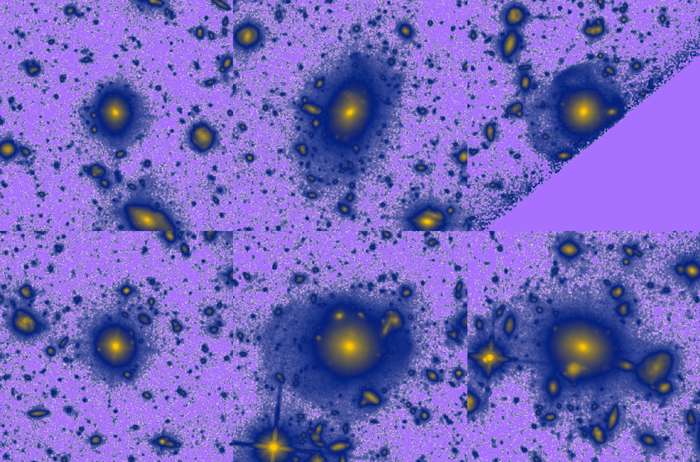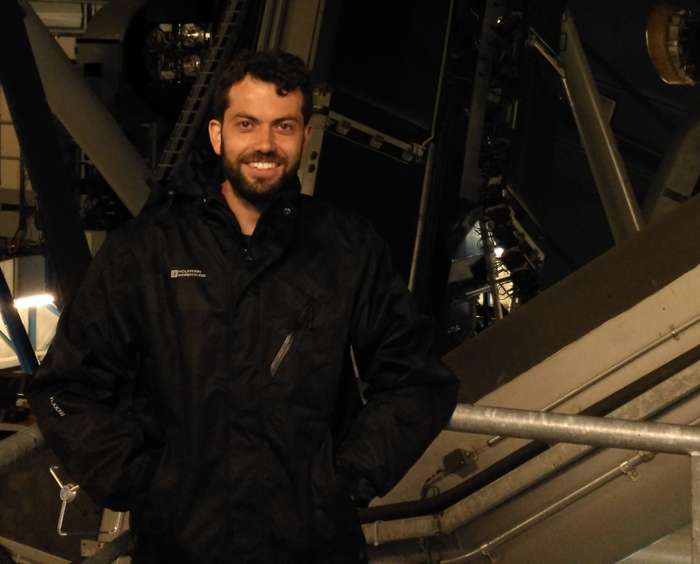ETG-HUDF12-IR. Credit: Instituto de Astrofísica e Ciências do Espaço
The most detailed study of the outskirts of massive elliptical galaxies at half the age of the Universe was carried out by an international team led by Fernando Buitrago, of Instituto de Astrofísica e Ciências do Espaço and Faculdade de Ciências da Universidade de Lisboa (FCUL). The study was published in the journal Monthly Notices of the Royal Astronomical Society and contributes to the understanding of how the largest galaxies of the Universe evolved over time.
Galaxies have dramatically grown in size since the early Universe, and elliptical galaxies, in particular, are the largest galaxies in both size and mass. What is the main driver behind the late growth of their outer parts was the question that motivated this study.
With disc galaxies, like our Milky Way, it is fairly easy to identify their distinct parts: the central bulge, the disc with its spiral arms, and a halo of stars enveloping the whole. Astronomers can tell, for instance, that the stellar halo is formed mostly by stars from satellite galaxies that merged into them.
For elliptical galaxies, however, this is much harder because these galaxies look much like a smooth, featureless cloud of stars. Fernando Buitrago (IA and FCUL) says: "With elliptical galaxies, there is direct evidence of merging of satellite galaxies going on, but it is hard to ascertain that the processes that have been happening for these galaxies to grow their outer envelopes are the same that we see occurring in disc galaxies like our own."
Credit: Instituto de Astrofísica e Ciências do Espaço
Hence, Buitrago and his team set out to investigate the nature of the outskirts of a sample of massive elliptical galaxies when the Universe was half its current age, roughly 6,2 billion years ago. Focusing their research on faint features at great distances from the galactic centre, they could only work with the deepest ever image of the Universe, the Hubble Ultra Deep Field (HUDF). Using the six galaxies that matched their criteria and are recorded in this image, the researchers were able to demonstrate for the first time the existence of extended stellar envelopes in individual massive elliptical galaxies at that period in time.
The quality of the information collected in the HUDF, enabled the team to characterise the individual galactic haloes and to place them in the context of the evolutionary history of this type of galaxies. Moreover, Buitrago and his team were able to conclude that, for their sample of massive elliptical galaxies at half the age of the Universe, the outer parts were, like disc galaxies, formed mainly due to the merging of other galaxies. They even attempted to identify in those haloes traces of recent episodes of galactic fusion.
The results emerged from the comparison of the sample with mathematical simulations based on the current model of galaxy formation and evolution. The team saw that, in this very case, the simulation and the real data matched very well and that it was possible to infer parallelisms.
"In elliptical galaxies, we cannot say 'this is the galactic bulge and this is the halo'," says Buitrago, "All the stars form a huge spheroid, like an immense rugby ball. But when we use a computer simulation, we can track the origin of every part of the simulated galaxy and compare with our real galaxies. Through this method, we identified the process behind the dramatic increase of these galaxies outer parts, and were able to explain how their size evolves."
More information: Fernando Buitrago et al. The cosmic assembly of stellar haloes in massive Early-Type Galaxies, Monthly Notices of the Royal Astronomical Society (2017). DOI: 10.1093/mnras/stw3382
Journal information: Monthly Notices of the Royal Astronomical Society
Provided by Instituto de Astrofísica e Ciências do Espaço

























